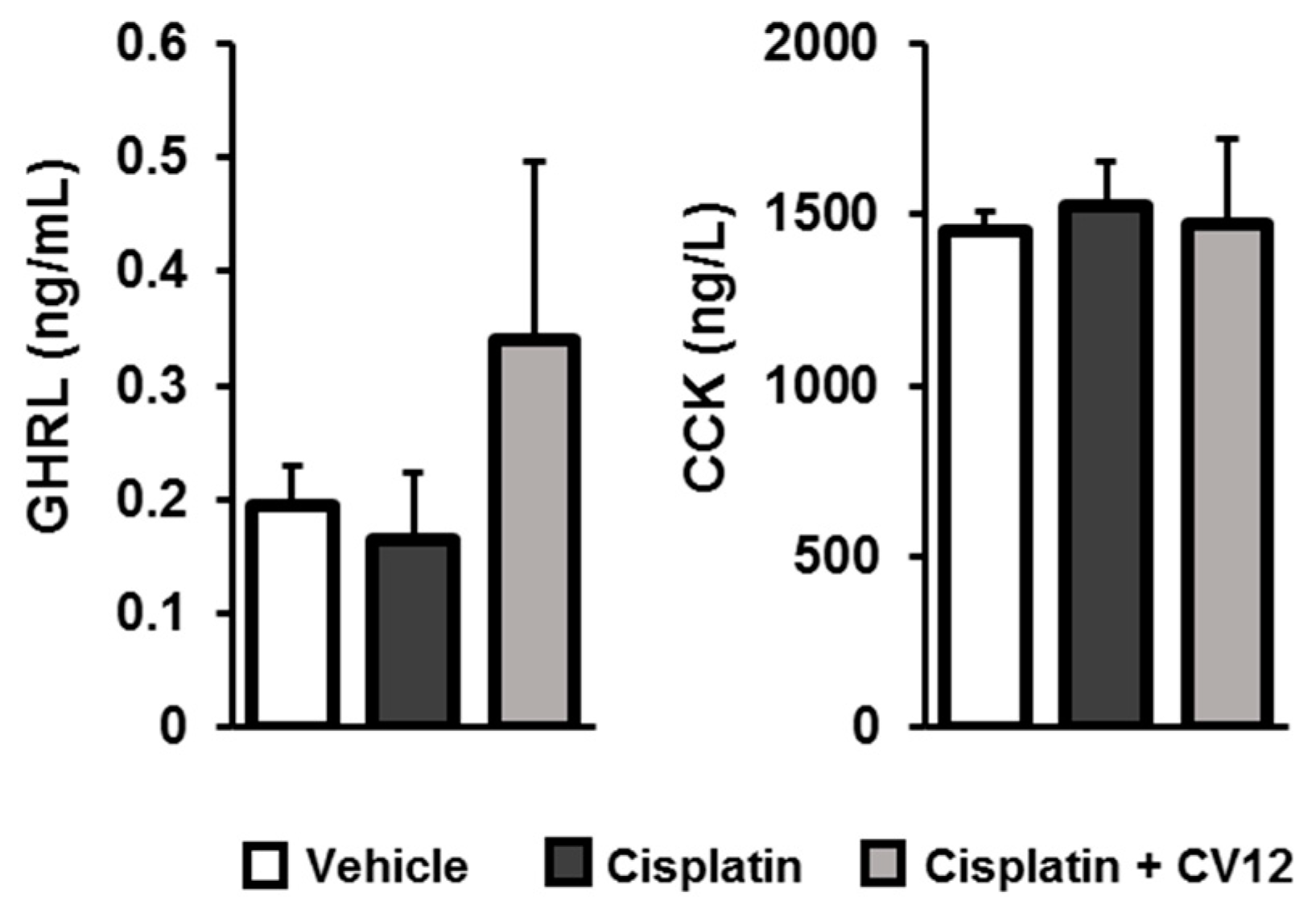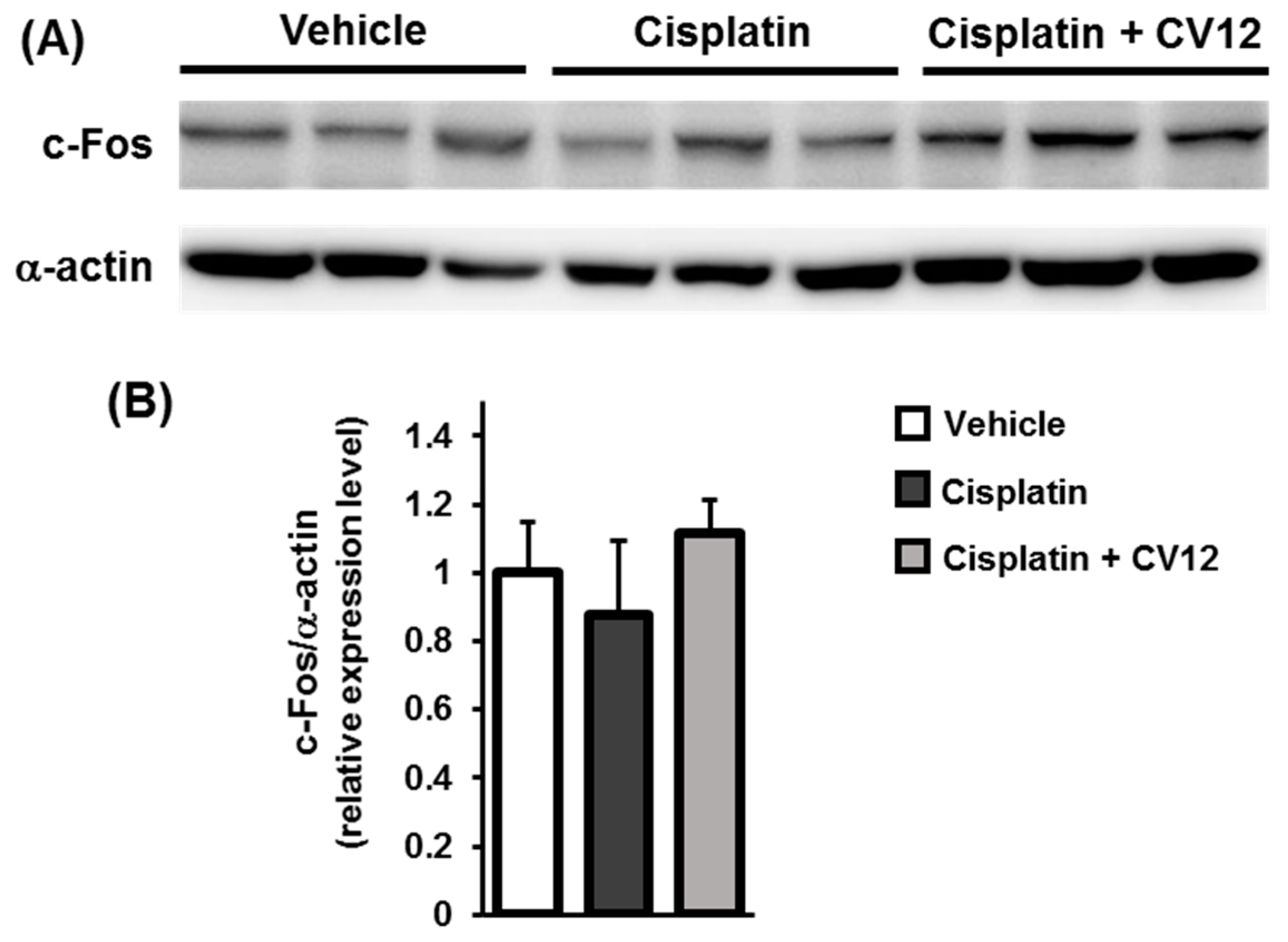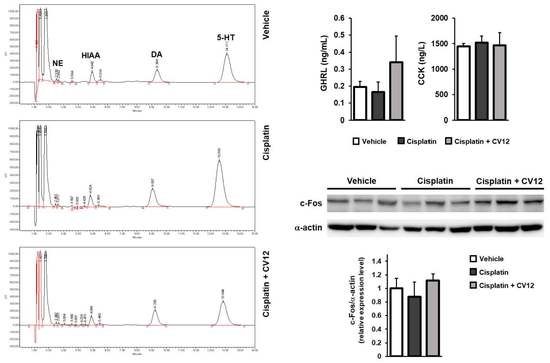Electro-Acupuncture Alleviates Cisplatin-Induced Anorexia in Rats by Modulating Ghrelin and Monoamine Neurotransmitters
Abstract
1. Introduction
2. Materials and Methods
2.1. Animals
2.2. Description of Study
2.3. Anorexia Model
2.4. Measurement of Body Weight and Daily Food Intake
2.5. Electro-acupuncture Treatment
2.6. Quantitative Analysis of Monoamine Neurotransmitters in Plasma
2.7. Measurement of Gastrointestinal Hormone Levels in the Plasma
2.8. RT-qPCR
2.9. Western Blotting Analysis
2.10. Statistical Analysis
3. Results
3.1. Evaluation of the Optimal EA Condition to Alleviate Cisplatin-Induced Anorexia
3.2. Plasma Monoamine Neurotransmitters’ Concentrations
3.3. Gastrointestinal Hormone Levels in Plasma
3.4. mRNA Expression Levels of GHRL, NPY, and POMC
3.5. c-Fos Expression in the NTS
4. Discussion
5. Conclusions
Author Contributions
Funding
Acknowledgments
Conflicts of Interest
Abbreviations
| 5-HIAA | 5-hydroxyindoleacetic acid |
| 5-HT | 5-hydroxytryptamine |
| CCK | cholecystokinin |
| DA | dopamine |
| EA | electro-acupuncture |
| ELISA | enzyme-linked immunosorbent assay |
| GHRL | ghrelin |
| HPLC-ECD | high performance liquid chromatography-electrochemical detection |
| i.p. | intraperitoneal |
| NE | norepinephrine |
| NPY | neuropeptide Y |
| NTS | nucleus tractus solitarii |
| POMC | pro-opiomelanocortin |
| qRT-PCR | quantitative reverse transcription - polymerase chain reaction |
References
- Jung, K.W.; Won, Y.J.; Kong, H.J.; Lee, E.S. Cancer Statistics in Korea: Incidence, Mortality, Survival, and Prevalence in 2016. Cancer Res. Treat. 2019, 51, 417–430. [Google Scholar] [CrossRef]
- Jung, K.W.; Won, Y.J.; Kong, H.J.; Lee, E.S. Prediction of Cancer Incidence and Mortality in Korea, 2019. Cancer Res. Treat. 2019, 51, 431–437. [Google Scholar] [CrossRef]
- Tisdale, M.J. Cancer anorexia and cachexia. Nutrition 2001, 17, 438–442. [Google Scholar] [CrossRef]
- Laviano, A.; Koverech, A.; Seelaender, M. Assessing pathophysiology of cancer anorexia. Curr. Opin. Clin. Nutr. Metab. Care 2017, 20, 340–345. [Google Scholar] [CrossRef]
- Muliawati, Y.; Haroen, H.; Rotty, L.A.W. Cancer anorexia-cachexia syndrome. Acta Med. Indones. Indones. J. Intern. Med. 2012, 44, 154–162. [Google Scholar]
- Laviano, A.; Meguid, M.M.; Rossi-Fanelli, F. Cancer anorexia: Clinical implications, pathogenesis, and therapeutic strategies. Lancet Oncol. 2003, 4, 686–694. [Google Scholar] [CrossRef]
- Laviano, A.; Meguid, M.M.; Inui, A.; Muscaritoli, M.; Rossi-Fanelli, F. Therapy insight: Cancer anorexia-cachexia syndrome—When all you can eat is yourself. Nat. Rev. Clin. Oncol. 2005, 2, 158–165. [Google Scholar] [CrossRef]
- Ezzo, J.; Richardson, R.M.; Vickers, A.; Allen, C.; Dibble, S.; Issell, B.F.; Lao, L.; Pearl, M.; Ramirez, G.; Roscoe, J.A.; et al. Acupuncture-point stimulation for chemotherapy-induced nausea or vomiting. Cochrane Database Syst. Rev. 2006. [Google Scholar] [CrossRef]
- Jeanette Ezzo, K.S. Antonius Schneider, Cochrane systematic reviews examine P6 acupuncture-point stimulation for nausea and vomiting. J. Altern. Complemen. Med. 2006, 12, 489–495. [Google Scholar] [CrossRef]
- Kim, M.; Kim, J.-E.; Kim, A.R.; Park, H.J.; Kwon, O.J.; Kim, B.K.; Cho, J.H.; Kim, J.H. Electroacupuncture for treating insomnia in patients with cancer: A study protocol for a randomised pilot clinical trial. BMJ Open 2017, 7, e016269. [Google Scholar] [CrossRef]
- Chen, H.; Liu, T.Y.; Kuai, L.; Zhu, J.; Wu, C.J.; Liu, L.M. Electroacupuncture treatment for pancreatic cancer pain: A randomized controlled trial. Pancreatology 2013, 13, 594–597. [Google Scholar] [CrossRef] [PubMed]
- Cui, Y.; Wang, L.; Shi, G.; Liu, L.; Pei, P.; Guo, J. Electroacupuncture alleviates cisplatin-induced nausea in rats. Acupunct. Med. 2016, 34, 120–126. [Google Scholar] [CrossRef] [PubMed]
- Liu, Y.; Zhang, S.; Ye, F.; Yin, J.; Li, S.; Chen, J.D.Z. Ameliorating effects and mechanisms of chronic electroacupuncture at ST36 in a rodent model of dyspepsia induced by cisplatin. Neurogastroenterol. Motil. 2019, 31, e13474. [Google Scholar] [CrossRef] [PubMed]
- Kang, K.S.; Huh, W.; Bang, Y.; Choi, H.J.; Baek, J.Y.; Song, J.H.; Kang, J.W.; Kim, T.H. Electroacupuncture for chemotherapy-induced anorexia through humoral appetite regulation: A preliminary experimental study. Exp. Ther. Med. 2019, 17, 2587–2597. [Google Scholar] [CrossRef]
- Li, Z.R. Experimental Acupuncture Science; China Press of Traditional Chinese Medicine: Beijing, China, 2003. [Google Scholar]
- Park, R.; Lee, K.I.; Kim, H.; Jang, M.; Ha, T.K.Q.; Oh, W.K.; Park, J. Reserpine treatment activates AMP activated protein kinase (AMPK). Nat. Prod. Sci. 2017, 23, 157–161. [Google Scholar] [CrossRef]
- Yoon, D.H.; Han, C.; Fang, Y.; Gundeti, S.; Han Lee, I.-S.; Song, W.O.; Hwang, K.-C.; Kim, T.W.; Sung, G.-H.; Park, H. Inhibitory activity of cordyceps bassiana extract on LPS-induced inflammation in RAW 264.7 cells by suppressing NF-κB activation. Nat. Prod. Sci. 2017, 23, 162–168. [Google Scholar] [CrossRef]
- Zhu, X.; Liu, Z.; Qin, Y.; Niu, W.; Wang, Q.; Li, L.; Zhou, J. Analgesic effects of electroacupuncture at ST25 and CV12 in a rat model of postinflammatory irritable bowel syndrome visceral pain. Acupunct. Med. 2018, 36, 240–246. [Google Scholar] [CrossRef]
- Ge, A.X.; Ryan, M.E.; Giaccone, G.; Hughes, M.S.; Pavletic, S.Z. Acupuncture treatment for persistent hiccups in patients with cancer. J. Altern. Complement. Med. 2010, 16, 811–816. [Google Scholar] [CrossRef]
- Kim, K.; Lee, S. Intradermal Acupuncture Along with Analgesics for Pain Control in Advanced Cancer Cases: A Pilot, Randomized, Patient-Assessor-Blinded, Controlled Trial. Integr. Cancer Ther. 2018, 17, 1137–1143. [Google Scholar] [CrossRef]
- Ng, J.; Papandreou, A.; Heales, S.J.; Kurian, M.A. Monoamine neurotransmitter disorders--clinical advances and future perspectives. Nat. Rev. Neurol. 2015, 11, 567–584. [Google Scholar] [CrossRef]
- Beaudoin-Gobert, M.; Sgambato-Faure, V. Serotonergic pharmacology in animal models: From behavioral disorders to dyskinesia. Neuropharmacology 2014, 81, 15–30. [Google Scholar] [CrossRef] [PubMed]
- Kim, M.H.; Lee, J.; Jung, S.; Kim, J.W.; Shin, J.H.; Lee, H.J. The involvement of ginseng berry extract in blood flow via regulation of blood coagulation in rats fed a high-fat diet. J. Ginseng Res. 2017, 41, 120–126. [Google Scholar] [CrossRef] [PubMed]
- Lam, D.D.; Przydzial, M.J.; Ridley, S.H.; Yeo, G.S.; Rochford, J.J.; O’Rahilly, S.; Heisler, L.K. Serotonin 5-HT2C receptor agonist promotes hypophagia via downstream activation of melanocortin 4 receptors. Endocrinology 2008, 149, 1323–1328. [Google Scholar] [CrossRef] [PubMed]
- Cambraia, R.P.B. Psychobiological aspects of feeding behavior. Rev. Nutr. 2004, 17, 217–225. [Google Scholar] [CrossRef]
- Ramos, E.J.B.; Suzuki, S.; Marks, D.; Inui, A.; Asakawa, A.; Meguid, M.M. Cancer anorexia-cachexia syndrome: Cytokines and neuropeptides. Curr. Opin. Clin. Nutr. Metab. Care 2004, 7, 427–434. [Google Scholar] [CrossRef]
- Yu, J.H.; Kim, M.S. Molecular mechanisms of appetite regulation. Diabetes Metab. J. 2012, 36, 391–398. [Google Scholar] [CrossRef]
- Yoichi Ueta, H.H. Etsuro Onuma, Yoh Takuwa, and Etsuro Ogata, Hypothalamic neuropeptides and appetite response in anorexia-cachexia animal. Endocr. J. 2007, 54, 831–838. [Google Scholar] [CrossRef]
- Yoshimura, M.; Matsuura, T.; Ohkubo, J.; Ohno, M.; Maruyama, T.; Ishikura, T.; Hashimoto, H.; Kakuma, T.; Yoshimatsu, H.; Terawaki, K.; et al. The gene expression of the hypothalamic feeding-regulating peptides in cisplatin-induced anorexic rats. Peptides 2013, 46, 13–19. [Google Scholar] [CrossRef]
- Holland, R.A.; Leonard, J.J.; Kensey, N.A.; Hannikainen, P.A.; De Jonghe, B.C. Cisplatin induces neuronal activation and increases central AMPA and NMDA receptor subunit gene expression in mice. Physiol. Behav. 2014, 136, 79–85. [Google Scholar] [CrossRef]
- Lee, J.H.; Min, D.S.; Lee, C.W.; Song, K.H.; Kim, Y.S.; Kim, H.P. Ginsenosides from Korean Red Ginseng ameliorate lung inflammatory responses: Inhibition of the MAPKs/NF-κB/c-Fos pathways. J. Ginseng Res. 2018, 42, 476–484. [Google Scholar] [CrossRef]
- Chen, B.; Hu, S.; Liu, B.; Zhao, T.; Li, B.; Liu, Y.; Li, M.; Pan, X.; Guo, Y.; Chen, Z.; et al. Efficacy and safety of electroacupuncture with different acupoints for chemotherapy-induced nausea and vomiting: Study protocol for a randomized controlled trial. Trials 2015, 16, 212. [Google Scholar] [CrossRef] [PubMed]
- Gao, L.; Chen, B.; Zhang, Q.; Zhao, T.; Li, B.; Sha, T.; Zou, J.; Guo, Y.; Pan, X.; Guo, Y. Acupuncture with different acupoint combinations for chemotherapy-induced nausea and vomiting: Study protocol for a randomized controlled trial. BMC Complement. Altern. Med. 2016, 16, 441. [Google Scholar] [CrossRef] [PubMed]
- Chen, B.; Guo, Y.; Zhao, X.; Gao, L.L.; Li, B.; Zhao, T.Y.; Zhang, Q.W.; Zou, J.X.; Li, M.Y.; Guo, Y.M.; et al. Efficacy differences of electroacupuncture with single acupoint or matching acupoints for chemotherapy-induced nausea and vomiting: Study protocol for a randomized controlled trial. Trials 2017, 18, 477. [Google Scholar] [CrossRef] [PubMed]
- Li, Q.; Yu, M.; Yang, G.; Wang, X.; Wang, H.; Zhang, C.; Xue, N.; Xu, W.; Fu, Q.; Yang, Z.; et al. Effect of acupuncture in prevention and treatment of chemotherapy-induced nausea and vomiting in patients with advanced cancer: Study protocol for a randomized controlled trial. Trials 2017, 18, 185. [Google Scholar] [CrossRef]





| Experimental Condition | Day −1 | Day 0 | Day 1 | Day 2 | Day 3 |
|---|---|---|---|---|---|
| 1st Experiment|Intensity of EA | |||||
| Cisplatin, i.p. | − | + | − | − | − |
| EA (low intensity stimulation) | − | − | + | + | + |
| EA (high intensity stimulation) | − | − | + | + | + |
| Body weight and food intake | + | + | + | + | + |
| 1st Experiment|Frequency of EA | |||||
| Cisplatin, i.p. | − | + | − | − | − |
| EA (10 Hz) | − | − | + | + | + |
| EA (100 Hz) | − | − | + | + | + |
| Body weight and food intake | + | + | + | + | + |
| 2nd Experiment|Pharmacological effects of the optimal EA conditions | |||||
| Cisplatin, i.p. | − | + | − | − | − |
| EA at non-acupoint | − | − | + | + | + |
| EA at CV12 (low intensity stimulation, 10 Hz) | − | − | + | + | + |
| Body weight and food intake | + | + | + | + | + |
| Blood, duodenum, and brain stem | − | − | − | − | + |
| Gene | Forward (5′ → 3′) | Reverse (5′ → 3′) |
|---|---|---|
| GHRL | AGCCCAGCAGAGAAAGGAAT | GTGGCTGCAGTTTAGCTGGT |
| NPY | TGTCTCAGGGCTGGATCTCT | TACTCCGCTCTGCGACACTA |
| POMC | GCTTCATGACCTCCGAGAAG | TCTTGATGATGGCGTTCTTG |
| β-actin | AAGTCCCTCACCCTCCCAAAAG | AAGCAATGCTGTCACCTTCCC |
© 2019 by the authors. Licensee MDPI, Basel, Switzerland. This article is an open access article distributed under the terms and conditions of the Creative Commons Attribution (CC BY) license (http://creativecommons.org/licenses/by/4.0/).
Share and Cite
Baek, J.Y.; Trinh, T.A.; Huh, W.; Song, J.H.; Kim, H.Y.; Lim, J.; Kim, J.; Choi, H.J.; Kim, T.-H.; Kang, K.S. Electro-Acupuncture Alleviates Cisplatin-Induced Anorexia in Rats by Modulating Ghrelin and Monoamine Neurotransmitters. Biomolecules 2019, 9, 624. https://doi.org/10.3390/biom9100624
Baek JY, Trinh TA, Huh W, Song JH, Kim HY, Lim J, Kim J, Choi HJ, Kim T-H, Kang KS. Electro-Acupuncture Alleviates Cisplatin-Induced Anorexia in Rats by Modulating Ghrelin and Monoamine Neurotransmitters. Biomolecules. 2019; 9(10):624. https://doi.org/10.3390/biom9100624
Chicago/Turabian StyleBaek, Ji Yun, Tuy An Trinh, Wonsang Huh, Ji Hoon Song, Hyun Young Kim, Juhee Lim, Jinhee Kim, Hyun Jin Choi, Tae-Hun Kim, and Ki Sung Kang. 2019. "Electro-Acupuncture Alleviates Cisplatin-Induced Anorexia in Rats by Modulating Ghrelin and Monoamine Neurotransmitters" Biomolecules 9, no. 10: 624. https://doi.org/10.3390/biom9100624
APA StyleBaek, J. Y., Trinh, T. A., Huh, W., Song, J. H., Kim, H. Y., Lim, J., Kim, J., Choi, H. J., Kim, T.-H., & Kang, K. S. (2019). Electro-Acupuncture Alleviates Cisplatin-Induced Anorexia in Rats by Modulating Ghrelin and Monoamine Neurotransmitters. Biomolecules, 9(10), 624. https://doi.org/10.3390/biom9100624








